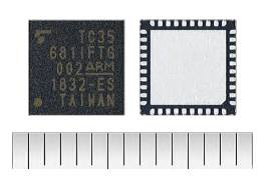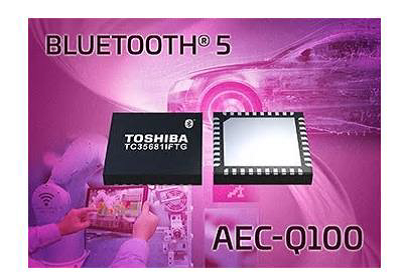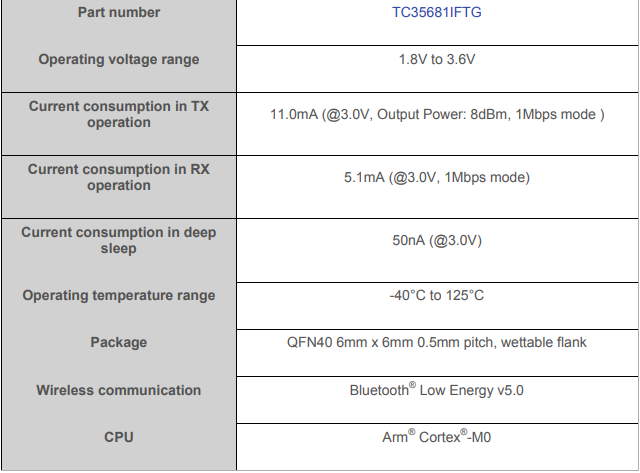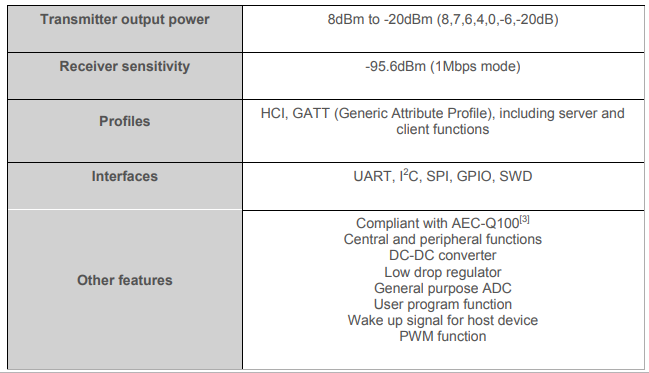October 30, 2018
Toshiba Electronic Devices & Storage Corporation
Highly expandable and integrated device will be fully AEC-Q100 qualified
 TOKYO—Toshiba Electronic Devices & Storage Corporation (“Toshiba”) has added “TC35681IFTG”, a new IC for automotive applications, to its line-up of ICs compliant with Bluetooth® low energy (LE)[1] core specification v5.0. The new device is suited to use in demanding automotive environments, as it delivers a wide operating temperature range, high RF transmission power and high RF reception sensitivity (a link budget of 113dB @125kbps at long range transmission). The mixed-signal TC35681IFTG contains both analog RF and baseband digital parts to provide a complete solution on a single chip.
TOKYO—Toshiba Electronic Devices & Storage Corporation (“Toshiba”) has added “TC35681IFTG”, a new IC for automotive applications, to its line-up of ICs compliant with Bluetooth® low energy (LE)[1] core specification v5.0. The new device is suited to use in demanding automotive environments, as it delivers a wide operating temperature range, high RF transmission power and high RF reception sensitivity (a link budget of 113dB @125kbps at long range transmission). The mixed-signal TC35681IFTG contains both analog RF and baseband digital parts to provide a complete solution on a single chip.
In addition to the basic functions of Host Controller Interface (HCI) profile and GATT profile functions, TC35681IFTG adds the new functions defined by Bluetooth® core specification 5.0[2] including 2Mbps throughput, Long Range and Advertising Extension functions, stored in internal mask ROM. It also integrates a high gain power amplifier and realizes +8dBm for long distance communication.
 When used in conjunction with an external non-volatile memory, the new IC becomes a fully-fledged application processor that temporarily loads applications and stores in internal RAM (76KB). It can also be combined with an external host processor.
When used in conjunction with an external non-volatile memory, the new IC becomes a fully-fledged application processor that temporarily loads applications and stores in internal RAM (76KB). It can also be combined with an external host processor.
The integration of 18 General Purpose IO (GPIO) lines and multiple communications options including SPI, I2C and a 921.6kbps, two-channel UART, gives TC35681IFTG the ability to form part of sophisticated systems. The GPIO lines offer access to a range of on-chip features including a wake-up interface, four-channel PWM interface and 5-channel AD converter. An on-chip DC-DC converter or LDO circuits adjust the external voltage supply to the required values on chip.
As it is designed to be compliant with AEC-Q100[3] , the low energy IC is primarily intended to be used in automotive applications. The wettable flank package simplifies automatic visual inspection needed to deliver the high levels of soldering quality required to withstand the vibration experienced in automotive applications.
Current applications include Remote Keyless Entry, On-Board Diagnostics to collect sensor data, Tire Pressure Monitoring Systems, and other contributors to improved vehicle comfort and safety.
Key Features
Low power consumption:
6.0mA (transmitter operation @3.0V, output power: 0dBm, 1Mbps mode)
6.5mA (transmitter operation @3.0V, output power: 0dBm, 2Mbps mode)
11.0mA (transmitter operation @3.0V, output power: 8dbm, 1Mbps mode)
11.5mA (transmitter operation @3.0V, output power: 8dBm, 2Mbps mode)
5.1mA (receiver operation @3.0V, 1Mbps mode)
5.5mA (receiver operation @3.0V, 2Mbps mode)
50nA in deep sleep (@3.0V)
High receiver sensitivity:
-95.6dBm (1Mbps mode)
-93.2dBm (2Mbps mode)
-101.2dBm(500kbps mode (S=2))
-105.2dBm(125kbps mode (S=8))
Supports Bluetooth® LE v5.0 central and peripheral devices
Built-in GATT (Generic Attribute Profile)
Supports servers and client functions defined by GATT
Additional features as defined by Bluetooth®
LE v5.0[2]
2Mbps
Long Range (Coded PHY)
Advertising Extension
Supports automotive reliability
Compliant with AEC-Q100[3]
Operation in wide temperature range
Wettable flank package
Applications

 Bluetooth®
Bluetooth®
low energy communication devices for automotive and industrial applications.
Main Specifications
Notes:
[1] Low power consumption communication technology defined in Bluetooth®
v4.0.
[2] Refer to Bluetooth®
core specification v5.0 for full details of added features.
[3] Qualification expected by spring of 2019.
* Bluetooth®
is a registered trademark of Bluetooth SIG, Inc.
* Arm and Cortex are registered trademarks of Arm Limited (or its subsidiaries) in the US and/or
elsewhere






